Skärjån
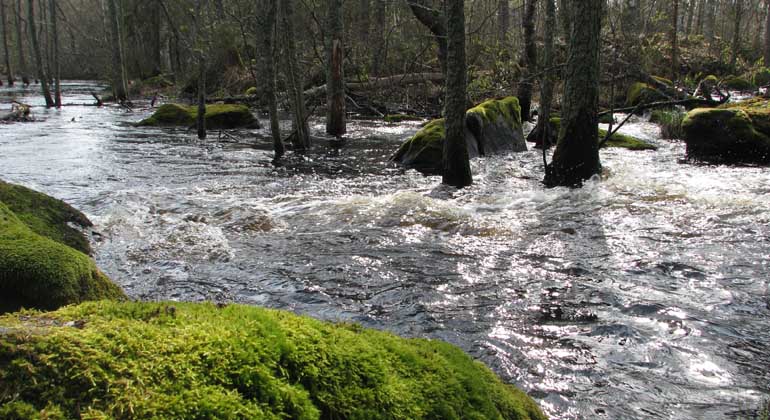
På våren kan Skärjån svämma över sina bräddar. Foto: Länsstyrelsen Gävleborg
Området sträcker sig från sjön Stor-Skärjan i väster till Axmar Bruk i öster. Ån är ett av länets mest värdefulla strömmande vattendrag med omgivande lövrika strandskogar. I Skärjåns naturreservat kan du promenera, fiska och uppleva områdets kulturhistoria.
Eller ta en paus vid grillplatserna och vindskydden. Gångbroarna över ån och skogarna bjuder på fina naturupplevelser. Området ligger väster om Axmar bruk och omfattar 192 hektar.
Människor har under lång tid uppehållit sig i området. Det finns spännande lämningar efter boplatser och kolningsanläggningar. Men även spår av flottning, sågverk samt järnframställning.
Skärjån har en sydlig prägel och vissa arter växer här längre norrut än vanligt. Ett exempel är ormbunken safsa som växer i det strömmande vattnet. De vanliga högörterna som fackelblomster, ängsruta, bunkestarr, svärdslilja och videört växer här. Men även de mer ovanliga och sydliga arterna hampflockel, strandklo och sjöranunkel. Olvon och små askskott är mycket vanliga.
I strandskogarna förekommer flera arter av taggsvampar. Strandzonen består till stora delar av flacka. Tidvis är de översvämmade marker med svämsediment. Här finns lummiga strandskogar med klibbal, glasbjörk, ask, asp och hägg, men också yngre partier av björk. På asp och ask kan du hitta skyddsvärda arter som korallblylav, stor aspticka och skinnlav.
Värdefullt för många
I ån lever både sällsynta arter. Det är arter som är känsliga för föroreningar eller försurning. Här finns till exempel flodpärlmussla och olika dagsländor. Fåglar som stjärtmes, gråspett och mindre hackspett trivs lövskogarna. I naturreservatet finns också strömstare och tretåig hackspett. Det finns även utter i området.
Fiskekartan.se är länsstyrelsernas register över fiskevårdsområden. Verktyget är en sökbar karta och här kan du se gränserna för alla Sveriges fiskevårdsområden. I samtliga vatten som visas i kartan krävs fiskekort. Här finns också mycket annan information, exempelvis vilka fiskarter som finns, länkar till fiskekortsförsäljare och föreningarnas webbplatser.
Information in english
The river logging path that follows along Skärjån was originally a bicycle path. It was built almost like a real road, with elevated embankments and bridges - though this road is less than a meter wide. In the past, there were no roads here in this forest. The transportation took place by foot or by boat. Therefore, there was a big change when the bicycle was introduced in the 1920s.
Now the river loggers at Skärjån could quickly move along the river logging path's dams and rapids. It became easier to get back and forth to work! For example, you could live in Axmar village, ten kilometers away, and go home in the evenings.
In fact, the bicycle was such an important means of transport for the workers in the forest that an entire infrastructure was built in northern Sweden for this, with hundreds of miles of cycle paths.
However, the history of bicycle paths did not last for long. Technological development went fast and during the 1950s, the car instead became cheaper and accessible in the same way as the bicycle 30 years earlier. The bicycle paths were replaced by forest roads. Today, there are not that many original bicycle routes left like this one. But new cycle paths are being built! Cycling in the forest has become popular - just like a hundred years ago.
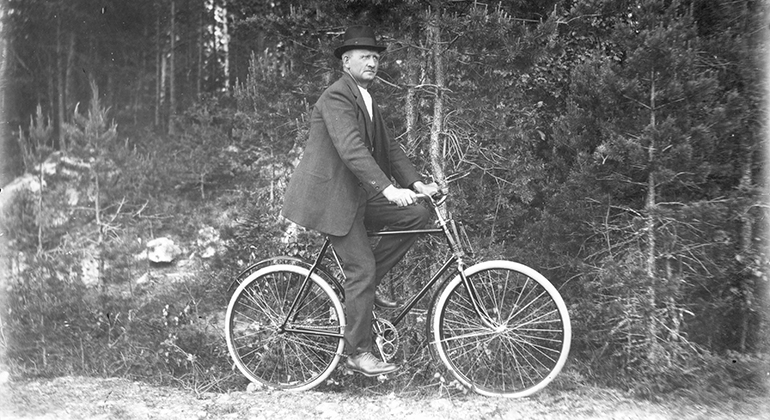
Photo: Länsmuseet Gävleborg
At the end of the 19th century, the forest acquired a value as timber. Thousands of hectares of forest land in the area were bought up by the company Bergvik & Ala. The forest would now be felled and supply sawmills and sulphite pulp mills around Ljusne with raw materials.
To get the logs out to the coast, it was planned to make Skärjån a logging route. It was important to make the logs flow smoothly without getting stuck, which was not easy in such a small and rocky watercourse. Therefore, an expert was hired, stream build master Herman Jonsson from Hennan, and with an extensive river cleaning, dam construction and building log gutters, he managed to get the logging trail completed in 1898. It had cost as much as 42,000 kronor, about four million in today's money value - but it was worth it!
The river logging lasted for 50 years. Skärjån was part of a larger transport route which included a narrow-gauge railway between Högbacka and Tönnebrosjön, and a long log channel from Viksjö. This went partly uphill, which was solved with steam engines and dams. There was thus never a shortage of logs. When everything worked, 25,000 logs per day could pass by these wind shelters.
However, as the road network expanded, river logging became increasingly unprofitable. Trucks took over the log transports and in 1949 logs was river transported for the last time in Skärjån. Despite the fact that it has been a long time, you can see tracks almost everywhere along the river: piles of cleaned blasted stone, dams, shorelines and watercourses - memories of the river logging era, and stream build master Herman!

Photo: Länsmuseet Gävleborg
At its peak, about 50 people worked in Skärjån's river logging streams. Their most important task was to ensure that the logs floated down the streams without getting stuck. If the logs got stuck, it quickly became a difficult-to-solve jumble of logs called a “Bröt”! in Swedish. Other tasks were to regulate dam levels to provide high waterflows to flush logs trough the streams. Five dams were included in the water system, and they all remain today.
Here at Snarforsen, the working task was to pull the logs to the log-sluices on both sides of the river that led the logs past the rapids. The labor was heavy and wet, but the most labor-intensive work was the separation at Överhammaren. There, construction timber and logs were sorted into railroad ties, which then went on to Överhammar sawmill. The rest was sent on down to the sea. With a boat hook, the river log-workers would find the marking on the logs that the lumberjack had made, and which determined the destination of the logs. Then the logs would be pulled to the right groove. The river logging working was a seasonal job. Many workers came from other areas and lived for a few months in the barracks by Lake Tönnebro.
With piecework salary, they could earn relatively well. There were also permanent staff who, after Rumpen - the last river logging of the season - worked with clearing the watercourses and salvaging sink logs. During the last years of river logging on Skärjån before it ceased in the 1940s, the job became somewhat easier. The rubber boots with long handles were introduced!
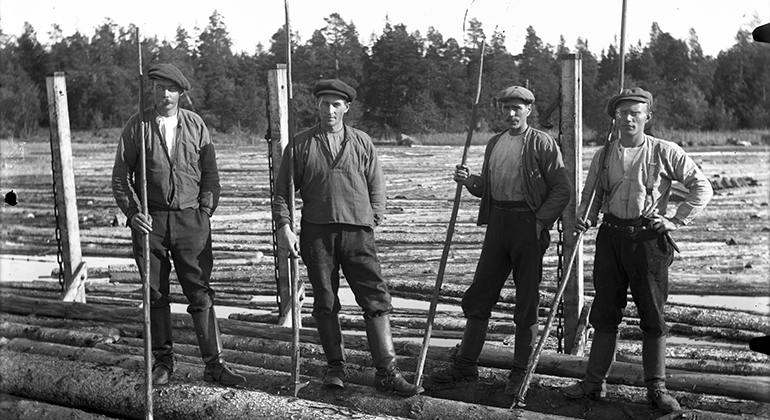
Photo: Länsmuseet Gävleborg

Illustration: Jonas Lundin
Around 500 years ago, fishery in Skärjån was already mentioned. In 1552, Gustaf Vasa's envoy wrote that there were several farmer-owned eel houses in the river and that he would have another built, which would only belong to the Crown! Eel fishing used to be important, so half of the catch was paid in taxes. An eelhouse was a fixed catching device in the form of a timber structure, sometimes with an overlaying structure like a house. In it, the eel was caught on its migration downstream, from the small lakes - where they grow large - to the open sea. When these lands were sold to the ironworks in Axmar at the end of the 17th century, the farmers were ensured that they would continue to have the rights to hunting and fishing - the forest itself was less important to them.
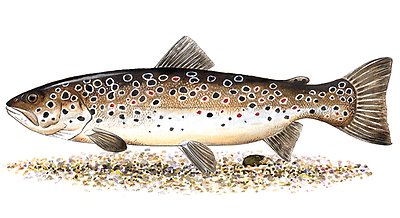
Illustration: Jonas Lundin
Even during the industrial era, fishing was of great importance. Well into the 19th century, there were eel houses in Skärjån that the Axmar mill owned. At the time when people worked at Överhammaren, fish from the river was a permanent part of their diet, the children were often responsible for catching the fish. During the river logging era, Skärjån underwent major changes. Tabby beaches and rocky streams - everything that the fish enjoyed - did not fit well with the river logging and were therefore removed since they wanted canals without stone and tabby edges that the timber otherwise could get stuck on. When the river logging ceased and the recreational fishing started to occur, restorations of the river began.

Illustration: Jonas Lundin
With non-profit forces, Ljusne flyfishing club (Ljusne flugfiskeklubb) started the work to improve conditions for trout (Salmo trutta) - put back rocks that the river loggers removed and reopen smaller connected streams.
The fish are now on their way back, keep your eyes open! With a little luck you can see a vigilant trout!

Illustration: Jonas Lundin
Riverbanks are what make Skärjån so valuable. Several forest areas are flooded during high water levels, which benefits certain deciduous trees and plants. This in turn means that rare lichens, mosses and insects can grow and live in the area. Along the river there are also areas of old meadows that are flooded occasionally. In these areas’ other types of plants, insects and amphibians thrive. Then, of course, there is the dry rocky coniferous forest with its own species. All in all, the river has a varied landscape with several habitat types - and a smorgasbord with food for many animals and birds.
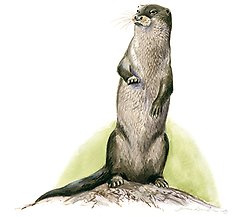
Illustration: Jonas Lundin
The otter (Lutra lutra) is one of those species who likes this nature. There are suitable beaches for building burrows, and long stretches of flowing open water where it can seek food without being disturbed by humans. In winter you can see slide tracks in the snow that the otter did. They can be made as either a scent marker of territory, or the otter simply thinks it's fun to go snow sliding!
Another thing that makes Skärjån special is that several species have their most northern distribution by the river. This is roughly where the biological northern border - Limes norrlandicus.

Illustration: Jonas Lundin
At the riverbanks, southern species such as European bugleweed (Lycopus europaeus), great spearwort (Ranunculus lingua) and hemp-agrimony (Eupatorium cannabinum) grow, which in folk medicine has been used for both emetics and wound healing.
The royal fern (Osmunda regalis), which is common further south, has Europe's northernmost population at Skärjån. The Swedish name (Safsa) comes from an old word for "know", in Swedish “veta”. In the past, it was thought that this fern could provide special skills.
A good knowledge is therefore to know what it looks like - Like this!
Skärjån has been pointed out as one of Gävleborg county´s most valuable watercourses. Species that otherwise lives much further south can be found here, but also other rare animals and plants. Some species are almost exclusively recognized only by experts, such as the aquatic beetle Stenelmis canaliculata. Others, like the beautiful dragonfly called the small pincertail (Onychogomphus forcipatus), most visitors will discover it as long as they know what to look for - a yellow / black dragonfly with a long hind body!

Illustration: Jonas Lundin
One species that thrives in Skärjån is the European bullhead (Cottus gobio). It is a small demersal fish that is territorial, it moves and search for food, mainly at night. The northern pike (esox lucius), perch (Perca fluviatilis) and European crayfish (Astacus astacus) are also common in Skärjån.
The European eel (Anguilla anguilla) is now rare, but it does occur. So do river European river lamprey (Lampetra fluviatilis), which used to be a common fish for food consumption. Great efforts have been made to get the trout (Salmo trutta) back to Skärjån. The trout is not only appreciated by fly fishermen but is also needed for the freshwater pearl mussel (Margaritifera margaritifera) for its life cycle.
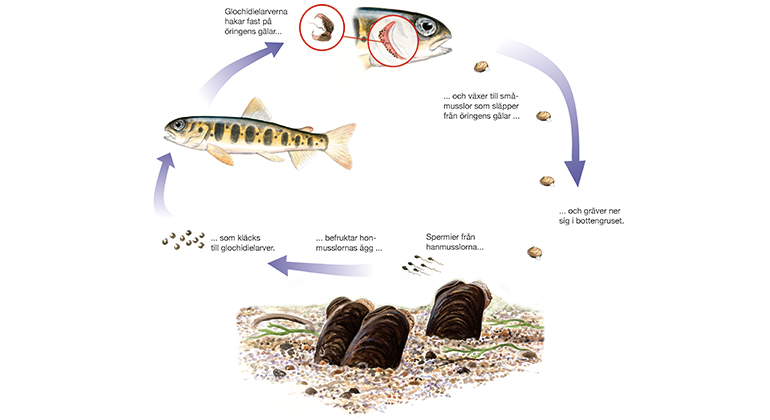
Illustration: Jonas Lundin
Here's how it works: The freshwater pearl's fertilized eggs hatch into very small larvae that are released into the water. With a good portion of luck, they can latch on to a trout's gills. Once there, they live for almost a year before they fall off and develop into a new mussel on the river bottom.
The freshwater pearl mussels found in Skärjån are mainly old individuals, and they can get very old! Some of today’s living mussels in the river lived as larvae on trout during the late 19th century - long before the timber floating, the bar iron hammer in Lill-Tönnebro and the harbor warehouses in Axmar mill. We must take care of and preserve such time travelers.
Do you think it somehow looks different in Skärjån, similar yet different? Maybe there is more rocks in the river? Maybe there is water on it places where it previously did not exist? Or feels more meandering than before? Yes, all of it is correct. Gävleborg county board has during 2020–2022 restored Skärjån river.
Historically, Skärjån has been used for logging and has therefore undergone big changes. To facilitate the logging, stone and blocks were removed the river was partially channeled. This led to the deterioration of important habitats for animals and plants such as trout and river pearl mussel.
In order to bring back the river's natural habitats, we have restored the river. We have demolished stone embankments along the riverbanks and thereby widened the river and opened previously closed lateral small streams. Stones and blocks have been put back in the waterway. As a result, the bottom has become more varied and in some places the water level has been raised. We have also added gravel to certain areas and felled trees to increase the amount of dead wood in the water.
In short, we have worked to make the river wild and varied again.
Aktuellt för detta besöksmål
Just nu har vi inga nyheter. Men håll utkik här efter kommande nyheter.
Föreskrifter
Inom naturreservatet gäller speciella regler. Det är inte tillåtet att:
- framföra motordrivet fordon annat än på väg som är avsedd för motorfordonstrafik. Undantag gäller körning med snöskoter på fruset och väl snötäckt underlag
- ta ved. Eldning är endast tillåten om egen ved tagits med, samt vid iordningställda eldplatser med egen eller ditlagd ved
- bryta kvistar, fälla eller på annat sätt skada levande eller döda stående eller omkullfallna träd och buskar
- skada, plocka eller samla in växter, svampar och alger. Bär-, matsvamp och blomplockning för eget behov är dock tillåten, med undantag för fridlysta och rödlistade arter
- klättra i boträd, uppehålla sig nära rovfågelbo, lya eller gryt, samla in djur eller på annat sätt medvetet skada eller störa djurlivet
- sätta upp tavla, plakat, affisch, skylt eller göra inskrift
- skada fast föremål eller ytbildning, så som att omlagra eller bortföra sten eller därmed jämförligt.
För fullständiga föreskrifter, se reservatsbeslutet.
Fakta
Skyddsår: 2015
Areal: 192 hektar
Karaktär: Vattendrag, skog, våtmark
Kommun: Gävle och Söderhamn
Förvaltare: Länsstyrelsen
Skyddsområde: naturreservat, Natura 2000
Hitta hit
Naturreservatet ligger 0-7 kilometer väster om Axmar bruk.
Norrifrån
Kör söderut ut på E4, sväng höger in på Axmarstig. Sväng vänster in på Överhammarsvägen, följ den vägen till du kommer fram till Skärjån naturreservat.
Söderifrån
Kör norrut på E4, sväng in höger in på Axmarstig.Sväng vänster in på Överhammarsvägen och följ den vägen till du kommer fram till Skärjån naturreservat.








